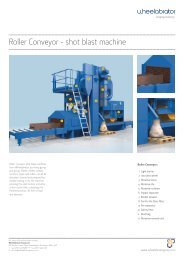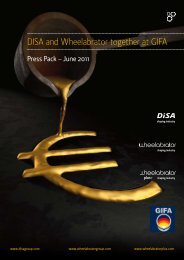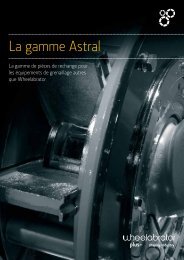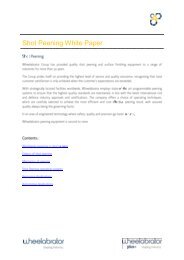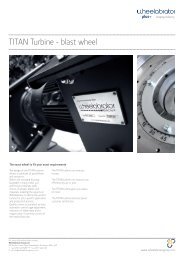Shipyards Brochure - Wheelabrator
Shipyards Brochure - Wheelabrator
Shipyards Brochure - Wheelabrator
You also want an ePaper? Increase the reach of your titles
YUMPU automatically turns print PDFs into web optimized ePapers that Google loves.
China<br />
<strong>Wheelabrator</strong> Group Ltd.<br />
Room 1823, Block 2,<br />
Bright China Chang An Building,<br />
No.7 Jianguomen Nei Avenue,<br />
Dongcheng District,<br />
Beijing 100005 - PR China<br />
T: +86 10 5911 1811 - 12/13<br />
F: +86 10 5911 1810<br />
E: info.beijing@wheelabratorgroup.com.cn<br />
DISA Trading (Shanghai) Co. Ltd.<br />
Room A901-903, Far East International Plaza<br />
No.319 Xian Xia Road<br />
Shanghai 200051 – PR China<br />
T: +86 21 6113 1799<br />
F: +86 21 6113 1788<br />
E: info.shanghai@wheelabratorgroup.com.cn<br />
Belgium<br />
<strong>Wheelabrator</strong> Group N.V.<br />
Airport Ring Center<br />
Maalbeekweg 61, B-1930 Zaventem<br />
T: +32 27190140<br />
F: +32 27190145<br />
E: info@wheelabratorgroup.be<br />
Canada<br />
<strong>Wheelabrator</strong> Group<br />
1219 Corporate Drive<br />
Burlington, Ontario L7L 5V5<br />
T: +1 (800) 845 8508 • T: +1 (905) 319 7930<br />
F: +1 (905) 319 7561<br />
E: info@wheelabratorgroup.com<br />
Czech Republic & Slovakia<br />
DISA Industries s.r.o.<br />
Za Balonkou 269<br />
CZ-260 01 Príbram 1<br />
T: +420 318 479 111<br />
F: +420 318 479 333<br />
E: pribram@wheelabratorgroup.com<br />
For more information please contact:<br />
<strong>Wheelabrator</strong> Group Ltd.<br />
41 Craven Road,<br />
Altrincham, UK<br />
WA14 5HJ<br />
Norican Group is the parent company of DISA and <strong>Wheelabrator</strong><br />
France<br />
<strong>Wheelabrator</strong> Group<br />
28-30 Rue de Tournenfils, BP 19<br />
91541 Mennecy-Cedex<br />
T: +33 (0) 1 64 57 21 21<br />
F: +33 (0) 1 64 57 05 59<br />
E: contact@wheelabratorgroup.fr<br />
<strong>Wheelabrator</strong> Group (Technology Centre)<br />
24, rue Camille Didier BP 39<br />
F-08001 Charleville-Mézières Cédex<br />
T: +33 (0) 324 33 63 21<br />
F: +33 (0) 324 37 39 37<br />
E: charleville@wheelabratorgroup.com<br />
Germany<br />
<strong>Wheelabrator</strong> Group GmbH<br />
Ferdinand-Porsche Str. 23<br />
D- 51149 Köln<br />
T: +49(0) 2203 297 51 0<br />
F: +49(0) 2203 297 51 60<br />
E: info@wheelabratorgroup.de<br />
<strong>Wheelabrator</strong> Group GmbH<br />
(Technology Centre)<br />
Heinrich-Schlick-Strasse 2<br />
D-48629 Metelen<br />
T: +49(0) 25 5688 0<br />
F: +49(0) 25 5688 150<br />
E: kontakt@wheelabratorgroup.de<br />
Hong Kong<br />
<strong>Wheelabrator</strong> Group Ltd.<br />
Unit 03, 11th Floor., Futura Plaza,<br />
111-113 How Ming Street,<br />
Kwun Tong, Kowloon, Hong Kong SAR<br />
T: +852 2827 1927<br />
F: +852 2877 6839<br />
E: info@wheelabratorgroup.com.hk<br />
T: +44 (0)161 928 6388<br />
F: +44 (0)161 929 0381<br />
E: uk-info@wheelabratorgroup.co.uk<br />
www.wheelabratorgroup.com<br />
India<br />
DISA India Ltd.<br />
5TH Floor, Kushal Garden Arcade<br />
1A Peenya Industrial Area<br />
Peenya 2nd Phase, Bangalore 560058<br />
T : +91 80 4020 1400 (01/02/03/04)<br />
F: +91 80 2839 1661<br />
E: bangalore@disagroup.com<br />
<strong>Wheelabrator</strong> Group Ltd.<br />
701 Blossoms,<br />
36/100 Gidney Park, Salisbury Park,<br />
Pune 411037 - India<br />
T: +91 937 247 3560<br />
F: +91 202 426 7623<br />
E: info@wheelabratorgroup.com.hk<br />
Japan<br />
DISA K.K.<br />
4F, Sumitomo Shoji Nagoya Marunouchi Bld.,<br />
3-5-10 Marunouchi Naka-ku Nagoya<br />
460-0002 Japan<br />
T: +81 52 950 7260<br />
F: +81 52 971 9450<br />
Mexico<br />
WG Plus Mexico S. De R.L. de C.V.<br />
Av. Universidad 1290, Local #19,<br />
Colonia Casa Bella<br />
San Nicolas de los Garza, Mexico 66428<br />
T: +52 81 8302 3631<br />
F: +52 81 8302 3632<br />
E: mexico@wheelabratorgroup.com<br />
Poland<br />
<strong>Wheelabrator</strong> Group<br />
ul. Wiertnicza 115<br />
PL-02-952 Warszawa<br />
T: +48 (0) 22 6 51 70 91<br />
F: +48 (0) 22 6 51 70 92<br />
E: info@wheelabratorgroup.pl<br />
Russia<br />
<strong>Wheelabrator</strong> Group<br />
Ul. Malakhitovaya 27, Building 1<br />
129128 Moscow<br />
T: +7 495 1815548<br />
F: +7 495 1815571<br />
E: info@wheelabratorgroup.ru<br />
Spain<br />
<strong>Wheelabrator</strong> Group S.L.U.<br />
Gran Via de les Corts Catalanes, 133 - 8º B<br />
E-08014 Barcelona<br />
T: + 34 93 421 1266<br />
F: + 34 93 422 3137<br />
E: contact@wheelabratorgroup.es<br />
Switzerland<br />
DISA Industrie AG<br />
Kasernenstrasse 1<br />
CH-8184 Bachenbülach<br />
Switzerland<br />
T: +41 44 815 40 00<br />
F: +41 44 815 40 01<br />
E: zurich@wheelabratorgroup.com<br />
United Kingdom<br />
<strong>Wheelabrator</strong> Group Ltd.<br />
41 Craven Road<br />
Altrincham, UK<br />
WA14 5HJ<br />
T: +44 (0) 161 928 6388<br />
F: +44 (0) 161 929 0381<br />
E: uk-info@wheelabratorgroup.co.uk<br />
USA<br />
<strong>Wheelabrator</strong> Group<br />
1606 Executive Drive<br />
LaGrange, GA 30240<br />
T: +1 (800) 544 4144 • T: +1 (706) 884 6884<br />
F: +1 (706) 884 0568<br />
E: info@wheelabratorgroup.com<br />
Subject to technical alteration • 10/09 • © wheelabrator<br />
Surface<br />
preparation
Shipyard Solutions<br />
<strong>Wheelabrator</strong> offers the widest range of surface preparation and engineering<br />
solutions.The sheer size of components and steel plates found in the shipping<br />
industry demands quite specifi c engineering capability. <strong>Wheelabrator</strong>‘s expertise<br />
has been tried and tested over many years, and many manufacturers have come<br />
to depend on the know-how, reliability and high quality service provided by<br />
<strong>Wheelabrator</strong> Group. This brochure is intended to give a brief overview of the<br />
many technologies and applications available.<br />
2 3
Pre-heating, blasting, coating, drying<br />
Ship building<br />
The size of metal sections used in the ship<br />
building industry presents great challenges for<br />
surface preparation and treatment suppliers.<br />
Huge quantities of sheet steel, profiles and<br />
fabrications have to be cleaned, treated and<br />
painted before final assembly. Corrosion<br />
protection is of paramount importance.<br />
The first part of the treatment process occurs<br />
on a preservation line, which incorporates the<br />
different stages of blasting and priming.<br />
On the preservation line, sheets and profiles<br />
are thoroughly blast cleaned and provided with<br />
a temporary corrosion protection coating.<br />
Along with the external transport unit,<br />
a preservation line consists of a pre-heating<br />
oven, a pass-through blasting machine, a<br />
painting unit and a drying tunnel with its<br />
associated slat conveyor.<br />
Typical plate widths can vary from 800mm to<br />
5m with process line speeds between 1.0m/<br />
min to 6.0m/min.<br />
Preservation line<br />
Sections 1 & 2:<br />
Cross transfer conveyor<br />
and inlet roller conveyor<br />
The first section of plant on this scale is the<br />
materials handling section, the cross transfer<br />
conveyor. The steel sheets and profiles are<br />
delivered here, and then fed into<br />
the treatment process by the Inlet Roller<br />
Conveyor.<br />
Section 3:<br />
Pre-heater<br />
The plates and profiles first pass through the<br />
pre-heater, this raises the temperature of<br />
the metal ready for blasting and removes any<br />
surface moisture.<br />
1 Cross transfer conveyor<br />
2 Inlet roller conveyor<br />
3 Pre-heater<br />
4 Roller conveyor shot blast machine<br />
5 Blast machine filter<br />
6 Paint spray chamber<br />
7 Paint supply system<br />
8 Filter from VOC-System<br />
9 VOC-System<br />
10 Drying chamber<br />
11 Slat conveyor<br />
12 Outlet roller table<br />
13 Cross transfer conveyor<br />
4 5<br />
1<br />
2<br />
5<br />
3<br />
9<br />
4<br />
8<br />
6<br />
13<br />
10<br />
7<br />
11<br />
12
Wheel blasting<br />
Preservation line<br />
Section 4:<br />
Roller conveyor shot blast machine<br />
The blast chamber removes rust and mill scale<br />
(fig 1) and provides a finish to internationally<br />
recognised preparation grades (fig 2) according<br />
to ISO 8501-1.<br />
Fig 1. Rust grades<br />
Four rust grades are specified. These are<br />
defined by precise written descriptions<br />
and photographic examples in ISO 8501-1<br />
documentation. They vary from A: mill scale,<br />
to D: where the mill scale has rusted away and<br />
general pitting is visible.<br />
Fig 2. Preparation grades<br />
Surface preparation by blast cleaning is<br />
designated by the international standard ISO<br />
8501. Four grades are specified, ranging from<br />
Sa 1: light blast cleaning, to Sa 3: blast cleaning<br />
to visually clean steel. Fig. 2. Shows surface<br />
preparation grades as applied to steel of rust<br />
grade B: a surface which has begun to rust<br />
and from which the millscale has begun to<br />
flake.<br />
Fig 1. Rust grades<br />
A B<br />
B Sa 1<br />
D C<br />
Fig 2. Preparation grades<br />
B Sa 2<br />
B Sa 3 B Sa 2½<br />
Preservation line<br />
Sections 4 & 5:<br />
Roller conveyor shot blast machine and filter<br />
The roller conveyor shot blast machine is the<br />
key piece of equipment in the preservation<br />
line.<br />
The position of the turbines is adapted to the<br />
specific requirement.<br />
Standard 1:<br />
When only plates and flat profiles are treated,<br />
the wheels are installed in line and the upper<br />
and the lower wheels have the same distance<br />
from the plates. This gives the fastest and<br />
most even, perfect blast result.<br />
Standard 2:<br />
A more universal blast machine is required<br />
when beams and pipes must also be treated.<br />
The wheels are arranged to ensure thorough<br />
cleaning of the side flanges.<br />
Roller conveyor machines can remove rust<br />
from sheets up to five metres wide, and have<br />
a working blasting speed of up to six metres<br />
per minute.<br />
The dust produced during the blast process<br />
is extracted by an automatic filter unit which<br />
cleans the exhaust air to a value below 2mg/m.<br />
Roller conveyor shot blast machine<br />
Conveyor detail<br />
Standard 1 Standard 2<br />
6 7
Quality control<br />
Quality control<br />
The controlled removal of rust and scale,<br />
and the generation of a consistent surface<br />
profile are critical to the successful bonding<br />
of coatings that follow. Throughout these<br />
processes the strict application of exhaustive<br />
quality controls is mandatory.<br />
Priming<br />
Sections 6-9:<br />
Paint spray chamber, voc-system and filter<br />
The various plate and profile widths are<br />
automatically identified and are coated in a<br />
continuous process with a weld-primer coating<br />
thickness of approximately 15 - 25μm.<br />
Paint dust and solvents (if no water based<br />
paint is used) are treated according to the local<br />
requirements in an automatic filter unit and a<br />
VOC-treatment plant.<br />
Sections 10 & 11:<br />
Drying chamber & slat conveyor<br />
This chamber can be heated by the exhausted<br />
air from the pre-heater (section 3). Additional<br />
circulation of high quantities of air accelerates<br />
the drying process.<br />
Lying on the support points of the conveyor<br />
cross slats (section 11), the wet primer remains<br />
undamaged at the plates pass through the<br />
drying chamber.<br />
Marking<br />
Each sheet has its own unique identification to<br />
allow subsequent allocation and control. The<br />
mark is spray painted by computer controlled<br />
nozzles. The paint can be fed from reservoirs<br />
or from the paint supplier‘s drums.<br />
Edge cleaning<br />
To ensure optimum weld quality, the edges of<br />
the profiles are blasted to remove paint from<br />
the weld area (sections 11-13). High through<br />
speeds are the rule.<br />
Airblast units for this operation are suitable<br />
for smaller profiles and often precede a gascutting<br />
machine.<br />
Sections 12 & 13:<br />
Conveying<br />
The plates are now conveyed to be fabricated<br />
into ship segments.<br />
8 9<br />
Quality control<br />
Edge blasting<br />
Edge cleaning airblast unit
Air blasting<br />
Air blasting<br />
After pre-treating the plates, they are built up<br />
into huge segments which are constructed to<br />
be as big as can possibly be handled.<br />
These huge components have to be reblasted<br />
around the welding seams and then given<br />
a protective coating in order to obtain a<br />
corrosion protection certificate.<br />
A weight of 100 tonnes or more for such<br />
a ship component is commonplace. The<br />
components are transported by special carriers<br />
into the respective blast and paint rooms<br />
where both interior and exterior surfaces are<br />
blasted.<br />
Filter units, with a capacity of up to<br />
200,000m³per hour, ensure good visibility, and<br />
abrasive storage silos holding up to 80 tonnes<br />
supply enough abrasive for uninterrupted<br />
blasting for long periods of time.<br />
Abrasive recovery<br />
After blasting, the tonnes of used abrasive<br />
have to be recovered. Abrasive from the inside<br />
of the segments is extracted with high vacuum<br />
suction units, removing up to 15 tonnes per<br />
hour.<br />
The abrasive that is used on the external<br />
surfaces can be pushed by a forklift truck,<br />
equipped with a scraper, to a collection hopper<br />
in one corner of the blast room. This is the<br />
easiest but most labour intensive version.<br />
Faster and wider automated systems such as<br />
vibrating chutes, storage screw conveyors and,<br />
in particular, the “Pulsostrip Air Plus” low-built<br />
mechanical conveying system ease and speed<br />
up the abrasive collection work.<br />
Air blasting Media silo with pressure vessel<br />
10 11
Painting and drying<br />
Painting and drying<br />
Painting is a critical part of the corrosion<br />
protection process and must meet strict<br />
quality criteria.<br />
Large component dimensions dictate that the<br />
painting process is performed in large painting<br />
halls, this requires great attention for both<br />
economic and ecological reasons.<br />
<strong>Wheelabrator</strong> has developed a specific wideangle<br />
nozzle air distribution technique which<br />
ensures good ventilation of the working area<br />
and a significant reduction of installed air<br />
movement, heating energy consumption, and<br />
thus operating costs.<br />
Similar to blasting, 50% to 70% of the painting<br />
work is carried out inside the welded sections.<br />
Ventilation within the sections is performed by<br />
grounded hoses for removing dust and solvent<br />
vapours. 1-C pumps as well as 2-C mixing and<br />
dosing units can be used. A unique fresh and<br />
exhaust air system has been developed to<br />
minimise operational costs.<br />
After the painting process the facility can be<br />
switched over to the drying process.<br />
Mobile systems for marine blasting<br />
and painting processes<br />
A full range of horizontal and vertical mobile<br />
systems are also available. Mobile systems are<br />
used to blast and coat the welds of new ship<br />
sections that are too large to fit in the blast<br />
rooms, and are used extensively in ship repair.<br />
Vacuum recovery units, dust collectors, specific<br />
application technology and other equipment<br />
are also available. Ask your <strong>Wheelabrator</strong><br />
representative for more detail.<br />
12 13
<strong>Wheelabrator</strong> Plus<br />
<strong>Wheelabrator</strong> Plus – the after-market<br />
division of <strong>Wheelabrator</strong><br />
<strong>Wheelabrator</strong> Plus is the after-market service,<br />
support and supply division of <strong>Wheelabrator</strong><br />
Group.<br />
Focused entirely on providing a customerfriendly<br />
solution that is affordable and<br />
profitable for the customer, the <strong>Wheelabrator</strong><br />
Plus team offers a whole range of services for<br />
all users of surface preparation equipment, no<br />
matter how large or small.<br />
If you use surface preparation equipment in<br />
your production processes, you need to be<br />
confident that you are getting the highest<br />
efficiency with optimum output at the lowest<br />
cost. This is where <strong>Wheelabrator</strong> Plus can<br />
help, with an extensive range of services<br />
including:<br />
• Equipment modernisation<br />
• Training<br />
• Maintenance and service programmes<br />
• Replacement parts and consumables<br />
Equipment Modernisation<br />
Programmes (EMP)<br />
Our dedicated team of engineers are able to<br />
assess your surface preparation equipment,<br />
including non-<strong>Wheelabrator</strong> machinery,<br />
and provide you with a report detailing<br />
modernisation recommendations to bring<br />
your equipment back to optimum efficiency,<br />
performance and safety.<br />
Service, maintenance and training<br />
<strong>Wheelabrator</strong> Plus will define a service<br />
and maintenance schedule to suit your<br />
requirements, and will provide staff to ensure<br />
that your equipment continues to work in the<br />
most productive manner.<br />
Training can be provided for your operations<br />
and maintenance staff on request.<br />
Replacement parts and consumables<br />
<strong>Wheelabrator</strong> Plus supplies original OEM<br />
replacement parts for our surface preparation<br />
equipment as well as pattern parts for<br />
non-<strong>Wheelabrator</strong> technologies.<br />
14 15



